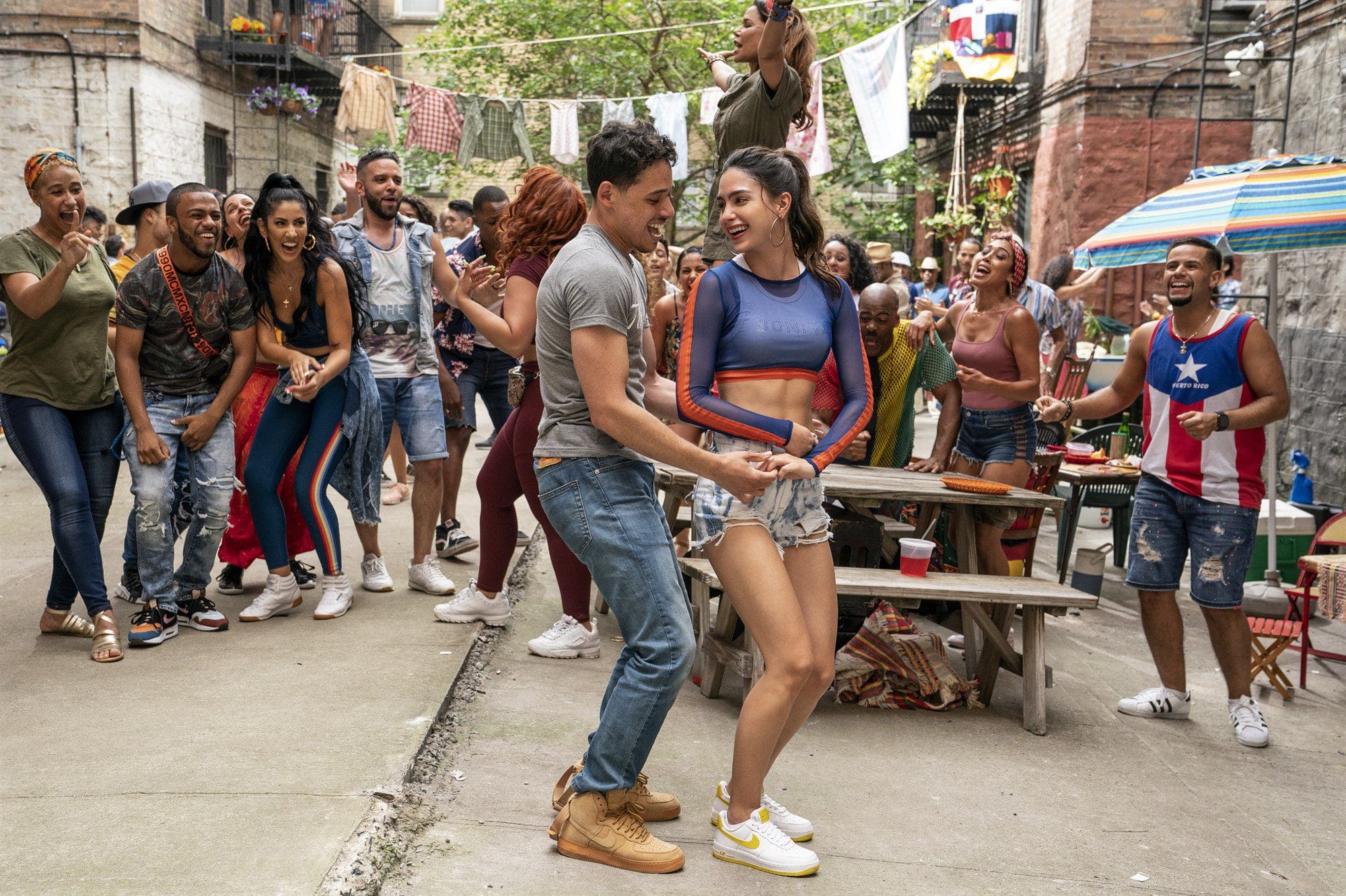
In the Heights’ opening number is glorious. As directed by Jon M. Chu, the Lin-Manuel Miranda-penned musical about Washington Heights’ Latinx community comes to vibrant, jubilant life. The streets of New York City are filled with color and beautiful dancing as the titular track introduces us to the cast of characters we’ll follow for the next two and a half hours. The scene is not only a perfect expression of the magic of movie musicals and the theater-going experience we’ve all missed so much, but a reintroduction to life after a year of isolation. It’s everything, but the rest of the film struggles to match it.
Our tour guide through this introduction is Usnavi, originally played by Miranda on the Broadway stage and by his Hamilton co-star, Anthony Ramos here. Usnavi runs a corner bodega in the Heights, but he’s preparing to move back to the Dominican Republic, which he left as a child and has dreamed about since. Though Usnavi is ostensibly our protagonist, the cast is filled with characters striving just as hard to achieve their dreams. There’s Vanessa (Melissa Barrera), an aspiring fashion designer hoping to move downtown. There’s Nina (Leslie Grace), returning from her first year at Stanford somewhat less bright-eyed and bushy-tailed than when she left. There’s salon owner Daniela (Daphne Rubin-Vega) and girlfriend Carla (Stephanie Beatriz), who are about to close up shop and reopen in the Bronx. Finally, there’s Abuela Claudia (Olga Merediz, who originated the role on Broadway), the neighborhood’s matron.
It’s a lot to keep track of and not only does Quiara Algeria Hudes’ script struggle to juggle these plot threads, but Chu can’t quite manage to keep the film from wildly shifting in tone with each new story beat. While the musical numbers propel the film undeniably forward, the energy shifts way down, almost coming to a standstill, in the dialogue scenes that connect them. The best example is Vanessa’s “I Want” song, “It Won’t Be Long.” It starts hopefully, with Vanessa singing as she leaves a neighborhood full of men who catcall her for the village streets where she hopes to realize her dreams. It’s a good song performed well by Barrera, but its rising emotion — and the music fueling it — are suddenly cut off so that Vanessa can share a far more subdued conversation first with an unforgiving real estate agent and then with Usnavi. Though that same pause happens in the musical, it’s extended here and when the music picks up again a few minutes later, almost as a reprise now, it’s hard to jump back into an emotional crescendo so long interrupted.
To his credit, Chu tries to smooth over that awkward tonal fluctuation by introducing elements that are perhaps best described as magical realism. As Vanessa runs through an empty street singing her hopes for a better future, colorful reams of fabric unfurl over the sides of apartment buildings. Though the moment is visually surprising and certainly a creative choice, it ultimately distracts from the emotions Barrera is already conveying so well. That said, many of Chu’s creative flourishes work well, particularly in thrilling group numbers like “96,000” or “No Me Diga.” Rather, it’s the way those flourishes overshadow more serious moments that grate.
Perhaps the most important example comes during the film’s climax, which takes place during a neighborhood-wide power outage that the film counts down to in the first half. As “Blackout,” a fast-paced number meant to dramatically heighten the character dynamics before the first act break, is building to the same thrilling energy level as “In the Heights,” the movie radically shifts gears for Abuela’s number, “Paciencia y Fe.” A fantasy sequence in which Abuela remembers her childhood in Cuba and her struggle to live in America, it is simultaneously possibly the film’s best musical number and its most difficult to accept.
As Abuela sings, she walks through an imaginary New York City, reminiscing on a darkened subway platform filled with dancers dressed like the people she remembers from mid-century Havana. It’s pure movie musical spectacle, but the shift in emotion and the huge, game-changing plot point that it delivers come so quickly on the heels of the other characters’ more melodramatic plot points that it can either make Abuela’s emotions feel overwrought or the other storylines feels slight.
However, while it would be easy to place the blame on “Paciencia y Fe” for bringing down an otherwise joyful musical, it’s actually the more serious and complex ideas that the film should have emphasized. Indeed, In the Heights is strongest when it leans into exploring the culture these characters inhabit and the challenges they face in America. The dancing doesn’t feel out of place like some of Chu’s artistic flourishes because the dancers who perform Christopher Scott’s intricate but understated choreography look like regular New Yorkers just going about their day. Just as leaving the Spanish dialogue un-translated or Chu’s choice to film these scenes in real New York City streets, those dancers bring the city to life in a way that gives it texture and veracity. Anything that doesn’t have that same air of accuracy feels out of place.
There are a lot of important ideas about the immigrant experience and how difficult America makes it for people of color to succeed in In the Heights, but the film can’t quite balance those stories with its big, bright musical sensibilities. Rather, they are subsumed by the romance plots, diluted into cliché or explored too shallowly because there is simply too much other ground to cover. There is so much life and beauty and truth fueling In the Heights, but Chu and his game cast only infrequently execute the material to its full potential. Instead, they constantly leave the audience yearning for more but, unlike the characters, we’re left unable to quite name what’s missing from our musical dream.


Comments are closed.